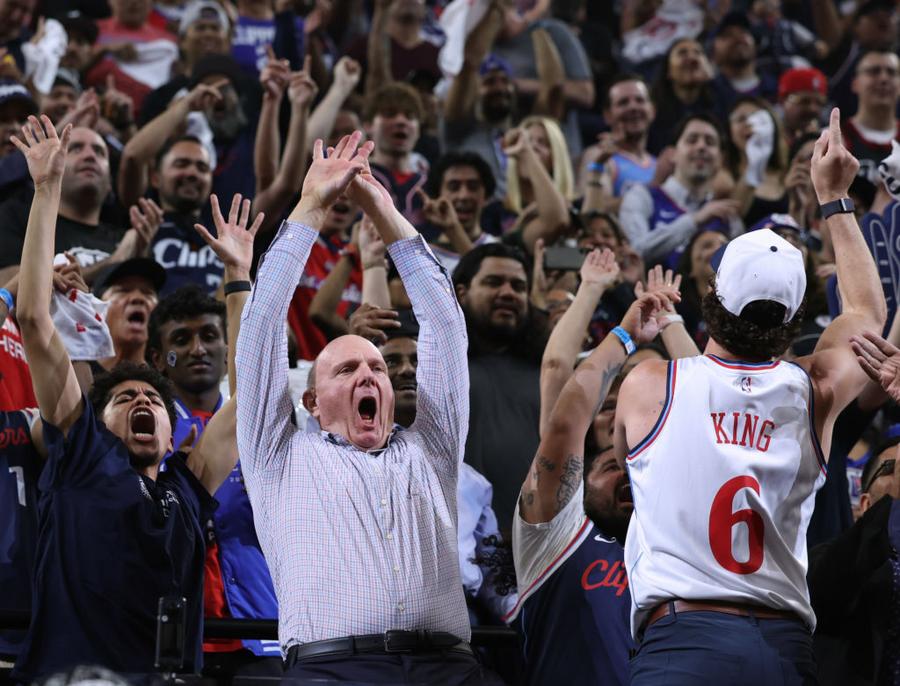The NBA recently wrapped up its All-Star Game, and, if online sentiment is any indication, this was perhaps the worst event yet. It's understandable—you come to watch the greatest stars of the game perform. Instead, you get things like Kevin Hart roasting players during the game (to their great annoyance), MrBeast hosting a half-court shooting contest, and just a baffling amount of stoppages for other ads and pageantry.
Yet, even if the NBA is getting roasted at the moment, the long-term health of the league is doing just fine financially. Per CNBC, the latest valuations find the average NBA team is worth $4.66 billion.
The Golden State Warriors, led by a decade-and-a-half of Stephen Curry, are the league's most valuable team. They're worth $9.4 billion and generated $781 million in revenue last year, both tops in the NBA. Meanwhile, the Memphis Grizzlies are the league's least valuable team. Even then, the franchise is still worth $3.2 billion and is growing at a solid pace.

Los Angeles Clippers owner Steve Ballmer. (Harry How/Getty Images)
The majority of the league is also making a healthy amount of profit, though two teams have a negative earnings before interest, taxes, depreciation, and amortization (EBITDA): The Milwaukee Bucks and Los Angeles Clippers.
Milwaukee had a -$14 million EBITDA, while the Clippers posted a whopping -$114 million EBITDA. The Phoenix Suns broke even with at $0.
Using the EBITDA metric generally gives us a good indicator of the profitability of a business. It's not without its flaws, but for a stable league like the NBA, we can get a decent sense of where teams stand.
Though the Bucks and Clippers both have negative EBITDA numbers, owning an NBA franchise opens doors for all kinds of other opportunities. Plus, it's such a rarified group that saying you own a team is super cool, especially for a fan like a Clippers owner Steve Ballmer.
And Ballmer's investment is a long-term, fruitful one. He bought the team in 2014 for $2 billion; today, the Clippers are worth more than 2.5 times that, valued at $5.4 billion.
Besides, Ballmer makes an estimated $1 billion per year from his Microsoft dividends. Even if the Clippers lost money this year, he's in great financial shape.
Why Are NBA Teams Worth So Much?
The rapid rise in franchise values is fueled by several factors, including:
- Media Rights Deals – The NBA's current TV contract with ESPN/TNT is worth $24 billion over nine years. The next deal, set to begin in 2025, is expected to be worth as much as $75 billion, nearly tripling annual broadcast revenue for teams.
- Sponsorships – The league brought in $1.66 billion in sponsorship revenue last year. Jersey patch sponsorships alone generate about $10-11 million per team annually, with top teams earning even more.
- Global Growth & Digital Expansion – The NBA has aggressively expanded its international footprint, particularly in China, Europe, and Africa, driving new streams of revenue through merchandise sales, broadcast deals, and online engagement.
- Limited Supply, High Demand – There are only 30 NBA teams, making them scarce assets in a world where billionaires and investment groups are eager to buy into the league's future growth.
NBA vs. Other Major Leagues: How Does It Compare?
While NBA teams have seen explosive value growth, the NFL still leads in overall valuations. The Dallas Cowboys are the world's most valuable sports franchise at $10.1 billion, and the average NFL team is worth $5-6 billion.
By contrast, MLB teams are worth significantly less, with an average valuation of $2.32 billion. Only the New York Yankees ($7.1 billion) rival the top NBA teams in value.
European soccer has a few powerhouses—Real Madrid ($6.6 billion) and Manchester United ($6.55 billion)—but most clubs are far below NBA and NFL team values due to different revenue structures.
Why Do Some NBA Teams Lose Money?
Despite these massive valuations, a few NBA teams actually lost money on an operating basis last year. The Los Angeles Clippers posted a staggering -$96 million EBITDA (earnings before interest, taxes, depreciation, and amortization), and the Milwaukee Bucks lost around -$16 million. Even the Phoenix Suns broke even at $0.
This may seem surprising, but these losses are often strategic investments:
- Arena Development Costs – Steve Ballmer's Clippers are building the $2 billion Intuit Dome, set to open in 2024.
- High Payroll and Luxury Taxes – The Bucks, Nets, and Clippers have been aggressive spenders, paying massive luxury taxes to stay competitive.
- Short-Term vs. Long-Term Strategy – Even if a team loses money today, its value continues to appreciate, making it a lucrative long-term asset.
Recent NBA Sales Show Insane Returns
Owning an NBA team has been one of the most lucrative investments of the past 40 years. Consider these jaw-dropping examples:
- In 1981, Donald Sterling bought the Clippers for $12.5 million. In 2014, he was forced to sell to Steve Ballmer for $2 billion—a 16,000% return.
- In 2010, Michael Jordan bought the Charlotte Hornets for $275 million. In 2023, he sold them for $3 billion—more than 10 times his original investment.
- The Milwaukee Bucks were bought for $550 million in 2014. When co-owner Marc Lasry sold his stake in 2023, the team was valued at $3.5 billion, a 6x increase in under a decade.
/2017/03/GettyImages-652227060.jpg)
/2016/01/GettyImages-514550722.jpg)
/2014/05/GettyImages-57107187.jpg)
/2015/10/nfl.jpg)
/2017/09/GettyImages-630223294.jpg)
/2017/07/GettyImages-633941332.jpg)
/2021/10/John-Boyega.jpg)
/2010/11/josh.jpg)
/2022/05/Nayib-Bukele.jpg)
:strip_exif()/2020/06/taylor.png)
/2010/11/russell-armstrong.png)
/2013/07/courtney-henggeler.jpg)
/2021/12/Lauren-Sanchez.jpg)
/2020/10/cate.jpg)
/2018/04/GettyImages-942450576.jpg)
/2021/08/bert-kreisher.jpg)
/2021/09/tom-segura.jpg)
/2023/09/john-mars.png)
/2010/01/Orlando-Bloom.jpg)
/2020/10/neil-young.jpg)
/2010/06/dario.jpg)
/2014/01/GettyImages-539540466.jpg)
/2012/08/broner.jpg)